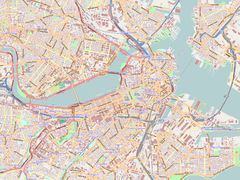 The Shawmut Street side of the Cocoanut Grove nightclub after the fire | |
| Date | November 28, 1942 |
|---|---|
| Time | Around 10:15 pm |
| Location | Bay Village, Boston, Massachusetts, U.S. |
| Coordinates | 42°21′0″N 71°4′6″W / 42.35000°N 71.06833°W |
| Cause | Ignition of decorative cloth |
| Deaths | 492 |
| Non-fatal injuries | 130 |
| Suspects | Barney Welansky |
| Charges | Manslaughter, numerous building code and safety violations |
| Verdict | Guilty |
| Convictions | Manslaughter |
The Cocoanut Grove fire was a nightclub fire which took place in Boston, Massachusetts, on November 28, 1942, and resulted in the deaths of 492 people. It is the deadliest nightclub fire in history and the third-deadliest single-building fire (after the September 11 attacks and Iroquois Theatre fire). The Cocoanut Grove was one of Boston's most popular nightspots, attracting many celebrity visitors. It was owned by Barnet "Barney" Welansky, who was closely connected to the Mafia and to Mayor Maurice J. Tobin. Fire regulations had been flouted: some exit doors had been locked to prevent unauthorized entry, and the elaborate palm tree décor contained flammable materials. The air-conditioning used flammable gas because of the wartime shortage of Freon.
During the first Thanksgiving weekend since the U.S. had entered World War II the Grove was filled to more than twice its legal capacity. The fire was initiated by an electrical short and fueled by methyl chloride in the air conditioning unit. Flames and smoke spread rapidly through all areas of the club, and people were unable to escape efficiently because of the locked exit doors. Blame was directed at Welansky for violation of standards; he served nearly four years in jail before being released just weeks before his death.
Local hospitals were especially well prepared to treat the casualties having been rehearsing emergency drills in response to possible wartime attacks on the East Coast. The crisis demonstrated the value of the recently installed blood banks and stimulated important advances in the treatment of burn victims. Following the fire many new laws were enacted for public establishments, including the banning of flammable decorations, a provision that emergency exits must be kept unlocked (from the inside), and that revolving doors cannot be the only exit.

